Desire Is as Desire Does: A Path of Suffering or a Path towards Enlightenment
Janelle Renée
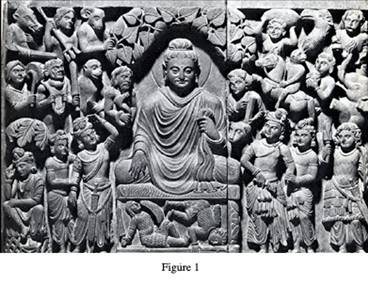
The historical Buddha was a man who discovered a way to live a life free from suffering. He developed an organized and logical system of instructions and explanations for anyone wishing to attain the same freedom he enjoyed, a life of equanimity. At the heart of this system are the Four Noble Truths that are central to Buddhist philosophy: (1) Life is suffering, (2) attachment to desire causes suffering, (3) suffering ends with the attachment to desire, and (4) the Eightfold Path is the path to liberation from suffering.1 When one reflects on these truths, it becomes evident that understanding and recognizing desire is not only fundamental to understanding Buddhist philosophy, but it can also help bring us one step closer to a life free of suffering. Using basic Buddhist principles as well as Buddhist art, I hope to explain Desire and to demonstrate that when all is said and done, Desire is as Desire does—desire can lead to a path of suffering and even destruction, or it can be employed by the diligent to propel oneself towards a more contented existence.
One cannot fully appreciate the nature and origin of desire unless one understands the stuff of which “the human personality is composed.”2This “stuff” is classified as the Five Aggregates of Clinging. (Clinging is “an intensified form of craving,”3 and craving is unchecked desire.) The five aggregates are consciousness, mental constructs (like thoughts, ideas, conceptions, etc.), physical or mental contact, objects (internal and external the body), and sensation. As one begins to understand each of the five aggregates, and their relationship to one another and within the system, then one begins to recognize them as the causal conditions they are.
The aforementioned aggregates of clinging are included in the “Nexus of Conditioned Origination,” a Buddhist doctrine that describes the causal conditions, like those mentioned above, and resulting phenomena, or simply put, it is a doctrine of cause and effect4. As far as the five aggregates of desire are concerned within that doctrine: when an internal or external object comes into contact with one of the six “sense-doors” (eyes, ears, mouth, skin, nose, and mind), sensation arises. In the state of ignorance, that is, not understanding the causal nature of the contact and sensation, desire or clinging becomes manifest. At this stage, consciousness is fully engaged. None of these elements—neither those that constitute the five aggregates nor those in the Nexus of Conditioned Origination, including our individual consciousness that we are habituated and inclined to name me,myself, and I—should be identified with, nor considered, “self” since they are impermanent and causal phenomena.
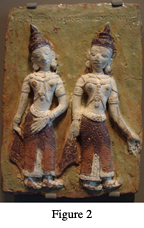
In Buddhist art and allegory, Desire is often personified as a daughter of a demon named Māra. Depending on which version of the story, Māra has as few as two daughters (see Figure 2) or as many as to constitute a legion. Māra sent his daughters to tempt the Buddha, and Desire was the last daughter to be defeated. How did the Buddha accomplish this? He simply touched the earth with his hand, as shown in artwork Figure 1 at the top of this paper. He rendered Desire ineffective by the power of reduction. As stated above, as a component of the “Nexus of Dependent Origination” doctrine, internal or external objects are sensed by our sense organs (including the mind), which in turn creates sensation. So, the sensation created by Desire’s taunts or the sensation of the dirt on the Buddha’s fingertips were both merely sensation. In other words, they are both impermanent causal phenomena that each have a source, so therefore neither can logically be associated with “self,” or the consciousness that is activated upon contact.
When this concept is not understood, one is a victim of ignorance and believes that the sensations, objects, and especially consciousness itself, can be owned or claimed as one’s own or one’s self. The problem with desire is that, or when, it arises out of ignorance. One fails to see that the object (be it internal or external) will bring about suffering because of its inherent impermanence. In this state of ignorance, Māra’s trappings cannot be avoided; he and his daughters are victorious.
When a practitioner understands the nature of desire, disinterest is naturally cultivated. This happens because attention is not activated beyond the act of simply noticing and recognizing events as causal phenomena. The events of contact, mental formation, and sensation, as well as any object sensed, can exist “independently” of the observer. That is to say, that although the observer senses the object (by seeing, tasting, feeling, etc.) he no longer becomes engaged on an attachment (personal or psychological or otherwise) level with it.
Obviously, elements considered pleasurable can induce desiring, craving, and clinging; however, desire not only arises in response to positive or attractive objects or mental formations. It arises as an aversion response as well. The response can be as extreme as the desire to flee or kill, or as trivial as avoidance. Basically, due to ignorance (again, a failure to see that there is no “self” since the consciousness we label as “self” is a causal phenomenon) people are unsettled and dissatisfied—this is fertile ground for desire. Aversion and craving are opposite sides of the same coin5, and if one doesn’t break the cycle of object-mental formation-sensation-craving, then it becomes reinforced as a self-sustaining condition and the cycle gets stronger and even more difficult to break.6
Buddhism wouldn’t be Buddhism, as life wouldn’t be life, without paradoxes. So, naturally, there is a paradox concerning desire: the desire for the cessation of suffering is necessary for suffering’s end. Without this desire, one is living in ignorance that one is even suffering or that there is a path that can free her from suffering, and so she therefore does not seek out its eradication. The good news is that one “can transform such cravings intovirya, vigor, which is intense desire directed toward spiritual growth:
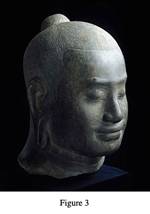
If, while holding on to concentration and one-pointedness of mind, one emphasizes desire, that is concentration of desire. One generates desire for the non-arising of unwholesome states that have not yet arisen; he puts forth effort and mobilizes energy… He generates desire for the arising of wholesome states that have not yet arisen; he puts forth effort and mobilizes energy.
(Samyutta Nikaya V.268)”7
The image of the bust in Figure 3 illustrates the peaceful content that comes as a result of properly channeled desire and successful practice. Unwholesome desire creates a self-containing, vicious karmic loop of ignorance and dissatisfaction. Unwholesome desire attempts to quench thirst with seawater, whereas wholesome desire recognizes the futility of drinking salted water and seeks to quench its thirst with pure snowmelt.
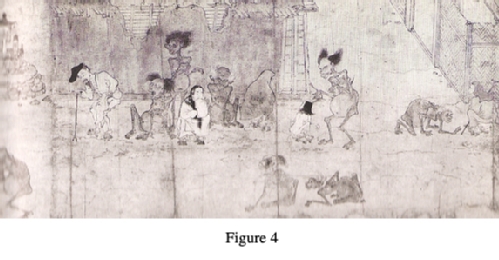
The concept of unwholesome desire is illustrated in the 12th century Japanese scroll above (Figure 4). The sinister looking creatures are Hungry Ghosts (Gaki Zoshi), and these restive spirits are set in contrast to the humans who they themselves are in various states of “ghosthood”—these stages are evident in their degree of clothedness and accumulation of body fat. The Hungry Ghosts symbolize the essence of unwholesome Desire—Its perpetual dissatisfaction drives it to be forever distracted by the next interesting thing, all the while it remains oblivious that the objects of its curiosities and fascinations are ultimately unfulfilling and causing the very dissatisfaction that drives It to seek out each successive new experience.
The emaciated, fully nude person crouching in the right third of the image seems to be most at risk of becoming a Hungry Ghost. While imitating the fully clothed and crouching human to his left, it seems he is being instructed by one of the Hungry Ghosts. It is safe to assume that the act of imitating another arises from a desire to be something other than what one is.
The book from which the Hunger Ghosts image was obtained, Buddhist Art and Architecture8, says that along with other unenviable people, “unethical priests” become Hungry Ghosts. Since an unethical priest would be one who places his desires above those whom he serves, we can understand him to be a victim of his selfish desire.
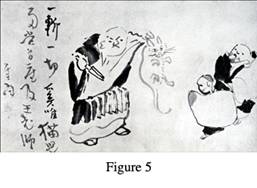
Curiously enough, as illustrated at the left in Figure 5, Desire kills the cat. The story goes as follows: Master Nan-ch'uan happened upon two monks having a quarrel about a cat. He cut the cat in two, because nobody responsed to his proposition, “If you can give an answer, you will save the cat. If not, I will kill it.” Later the master retold the story to another master named Chao-chou, who replied by putting his sandals on his head and leaving without saying a word. To this, Nan-ch'uan responded, "If you had been there, you would have saved the cat."9
The master taught several lessons about Desire to the quallering monks by following through the act of killing the cat. The fact that the monks remain in the presence of the master and doomed cat proves that both monks are possessed by Desire to see the argument’s conclusion and the cat’s fate. The cat is a source of suffering, since it is an impermanent thing. The monks failed to see this and became attached to their respective positions to the point of arguing with one another. The cat would have lived had the monks demonstrated, or cultivated, disinterest along any point of the story, as Chao-chou masterfully did.
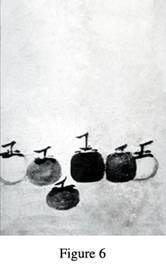
The painting to the left (Figure 6) by Zen artist Mu Ch’i demonstrates that a concentrated and wholesome Desire to see things as they are gives an unadulterated view of reality. Because Mu Ch’i doesn’t dazzle us with color or glimmer, our eye is drawn towards the richer subtleties of the persimmon. We approach the image with a curiosity about the form, energy, and persimmon essence. Color and light would distract from this study and perhaps entice a desire to eat something sweet and ripe. This painting is a call to study the richer subtleties of our mind and our life by learning to recognize when we are being dazzled with superficialities created by Māra’s daughter Desire.In conclusion, we see that desire is as desire does. At one end of the spectrum, Desire runs amok and arguments lead to murder. On the other end of the spectrum, wholesome Desire is cultivated and channeled to lead one to enlightenment or enlightened works of art. Still, at the end of the day, as the first Noble Truth states: Life is suffering. Even sitting for hours on end in meditation to cultivate suffering’s end can lead to hemorrhoids, as shown in Figure 7. The same practical desire that leads even the least enlightened among us to treat physical manifestations of suffering—be it reaching for aspirin or subjecting ourselves to burning moxibustion, like the Zen master in Figure 7—is the same wholesome Desire seed we can cultivate to bring about the fruits of enlightenment.
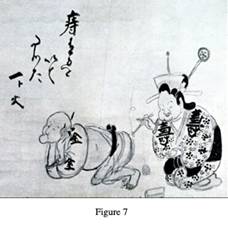
References:
- Easwaran, Eknath. Dhammapada. Tomales, California: Nilgiri Press, 2007, pp. 43-44.
- Boisvert, Mathieu. Five Aggregates: Understanding Theravada Psychology and Soteriology. Waterloo, Ontario, Canada: WilfridLaurier University Press, 1995, p. 5.
- Leaman, Oliver. Key Concepts in Eastern Philosophy. Florence, Kentucky: Routledge, 1999, p. 63.
- Boisvert, p. 134.
- Boisvert, p. 134.
- Easwaran, p. 85.
- Easwaran, p. 229.
- Fisher, Robert E. Buddhist Art and Architecture. London: Thames and Hudson Ltd., 1993.
- Mikkelson, Douglas K. Who is Arguing about the Cat? Moral Action and Enlightenment According to Dogen. Philosophy East & West, July 1997. Vol. 47, Issue 3, p. 383.
Additional consulted sources:
- The Middle Length Discourses of the Buddha: A Translation of the Majjhima Nikāya. Trans. Bhikkhu Ñāṇamoli and Bhikkhu Bodhi. 2nd ed. Boston: Wisdom Publications, 2001.
- Rahula, Walpola. What the Buddha Taught. New York: Grove Press, Inc., 1962.
- Schumann, Hans Wolfgang. Buddhism: An Outline of its Teachings and Schools. Wheaton, IL: Theosophical Publishing House, 1973.
Images:
- Figure 1 The Assault of Mara’s Host. Kushan from Gandhara frieze. 2nd century.
- Figure 2 Daughters of the Demon Māra. 1460-1470, Southern Burma (Myanmar). Glazed terra cotta, Asian Art Museum, San Francisco. Photo credit: Janelle Renée.
- Figure 3 Hungry Ghosts from the Gaki Zoshi Scroll (Kawamoto version), late 12th century, Kamakura period, Japan. Ink and colors on paper. Buddhist Art and Architecture. London: Thames and Hudson Ltd, 1993, page 163.
- Figure 4 Jayvarman VII. Late12th – early 13th century. Cambodia. Sandstone. Musée Guimet, Paris. Photo credit: RMN, Jean Paul Pinon, Thierry Ollivier, Michel Urtado 3D.
- Figure 5 Sengai, Gibon. Nan-Ch’uan Cutting Cat in Two. 1750-1837. Japan. Hanging scroll, ink on paper.
- Figure 6 Mu Ch’i. Six Persimmons. 12th century.
- Figure 7 Hakuin, Ekaku. Curing Hemorrhoids by Moxibustion. 18th century.
- “As long as there is this ‘thirst’ to be and to become, the cycle of continuity (samsara) goes on. It can stop only when its driving force, this ‘thirst’, is cut off through wisdom which sees Reality, Truth, Nirvana.”
- —Walpola Rahula from What the Buddha Taught.